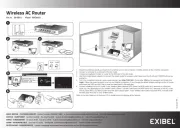D-Link DIR-657 Manual
Læs gratis den danske manual til D-Link DIR-657 (120 sider) i kategorien Routere. Denne vejledning er vurderet som hjælpsom af 12 personer og har en gennemsnitlig bedømmelse på 5.0 stjerner ud af 6.5 anmeldelser.
Har du et spørgsmål om D-Link DIR-657, eller vil du spørge andre brugere om produktet?

Produkt Specifikationer
| Mærke: | D-Link |
| Kategori: | Routere |
| Model: | DIR-657 |
Har du brug for hjælp?
Hvis du har brug for hjælp til D-Link DIR-657 stil et spørgsmål nedenfor, og andre brugere vil svare dig
Routere D-Link Manualer


Routere Manualer
- König
- Trust
- Western Digital
- Asus
- Technicolor
- EnGenius
- TP-Link
- Sitecom
- Clas Ohlson
- Exibel
- Gembird
- Linksys
- Phicomm
- Eminent
- Tilgin
Nyeste Routere Manualer









